MBA Organizational Behavior Assignment: Case Study Analysis
VerifiedAdded on 2021/07/07
|5
|1732
|138
Homework Assignment
AI Summary
This MBA assignment delves into organizational behavior through two case studies and an exploration of incentives. The first case examines differing perceptions and attitudes within Clarkston Industries, focusing on a manager's dilemma regarding an employee with a troubled past. The second case analyzes group behavior within a task force designing a new product line, highlighting the impact of diverse perspectives and decision-making processes. The assignment also requires students to research and evaluate various employee incentives, linking them to employee needs and assessing their effectiveness. Students are prompted to identify unusual incentives, relate them to employee needs, and analyze their strengths and weaknesses. This assignment encourages critical thinking, research skills, and the application of organizational behavior concepts to real-world scenarios.
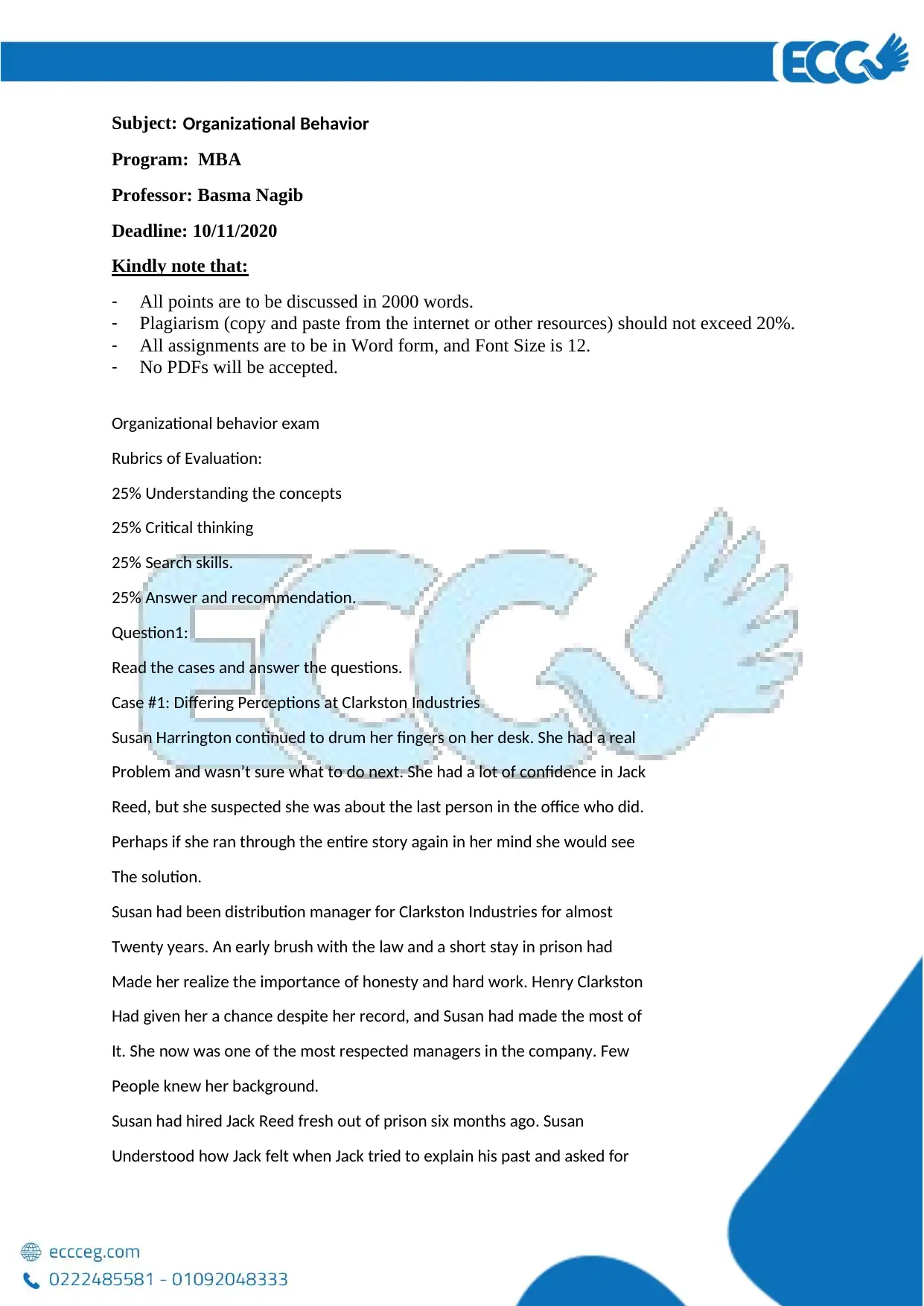
Subject: Organizational Behavior
Program: MBA
Professor: Basma Nagib
Deadline: 10/11/2020
Kindly note that:
- All points are to be discussed in 2000 words.
- Plagiarism (copy and paste from the internet or other resources) should not exceed 20%.
- All assignments are to be in Word form, and Font Size is 12.
- No PDFs will be accepted.
Organizational behavior exam
Rubrics of Evaluation:
25% Understanding the concepts
25% Critical thinking
25% Search skills.
25% Answer and recommendation.
Question1:
Read the cases and answer the questions.
Case #1: Differing Perceptions at Clarkston Industries
Susan Harrington continued to drum her fingers on her desk. She had a real
Problem and wasn’t sure what to do next. She had a lot of confidence in Jack
Reed, but she suspected she was about the last person in the office who did.
Perhaps if she ran through the entire story again in her mind she would see
The solution.
Susan had been distribution manager for Clarkston Industries for almost
Twenty years. An early brush with the law and a short stay in prison had
Made her realize the importance of honesty and hard work. Henry Clarkston
Had given her a chance despite her record, and Susan had made the most of
It. She now was one of the most respected managers in the company. Few
People knew her background.
Susan had hired Jack Reed fresh out of prison six months ago. Susan
Understood how Jack felt when Jack tried to explain his past and asked for
Program: MBA
Professor: Basma Nagib
Deadline: 10/11/2020
Kindly note that:
- All points are to be discussed in 2000 words.
- Plagiarism (copy and paste from the internet or other resources) should not exceed 20%.
- All assignments are to be in Word form, and Font Size is 12.
- No PDFs will be accepted.
Organizational behavior exam
Rubrics of Evaluation:
25% Understanding the concepts
25% Critical thinking
25% Search skills.
25% Answer and recommendation.
Question1:
Read the cases and answer the questions.
Case #1: Differing Perceptions at Clarkston Industries
Susan Harrington continued to drum her fingers on her desk. She had a real
Problem and wasn’t sure what to do next. She had a lot of confidence in Jack
Reed, but she suspected she was about the last person in the office who did.
Perhaps if she ran through the entire story again in her mind she would see
The solution.
Susan had been distribution manager for Clarkston Industries for almost
Twenty years. An early brush with the law and a short stay in prison had
Made her realize the importance of honesty and hard work. Henry Clarkston
Had given her a chance despite her record, and Susan had made the most of
It. She now was one of the most respected managers in the company. Few
People knew her background.
Susan had hired Jack Reed fresh out of prison six months ago. Susan
Understood how Jack felt when Jack tried to explain his past and asked for
Paraphrase This Document
Need a fresh take? Get an instant paraphrase of this document with our AI Paraphraser
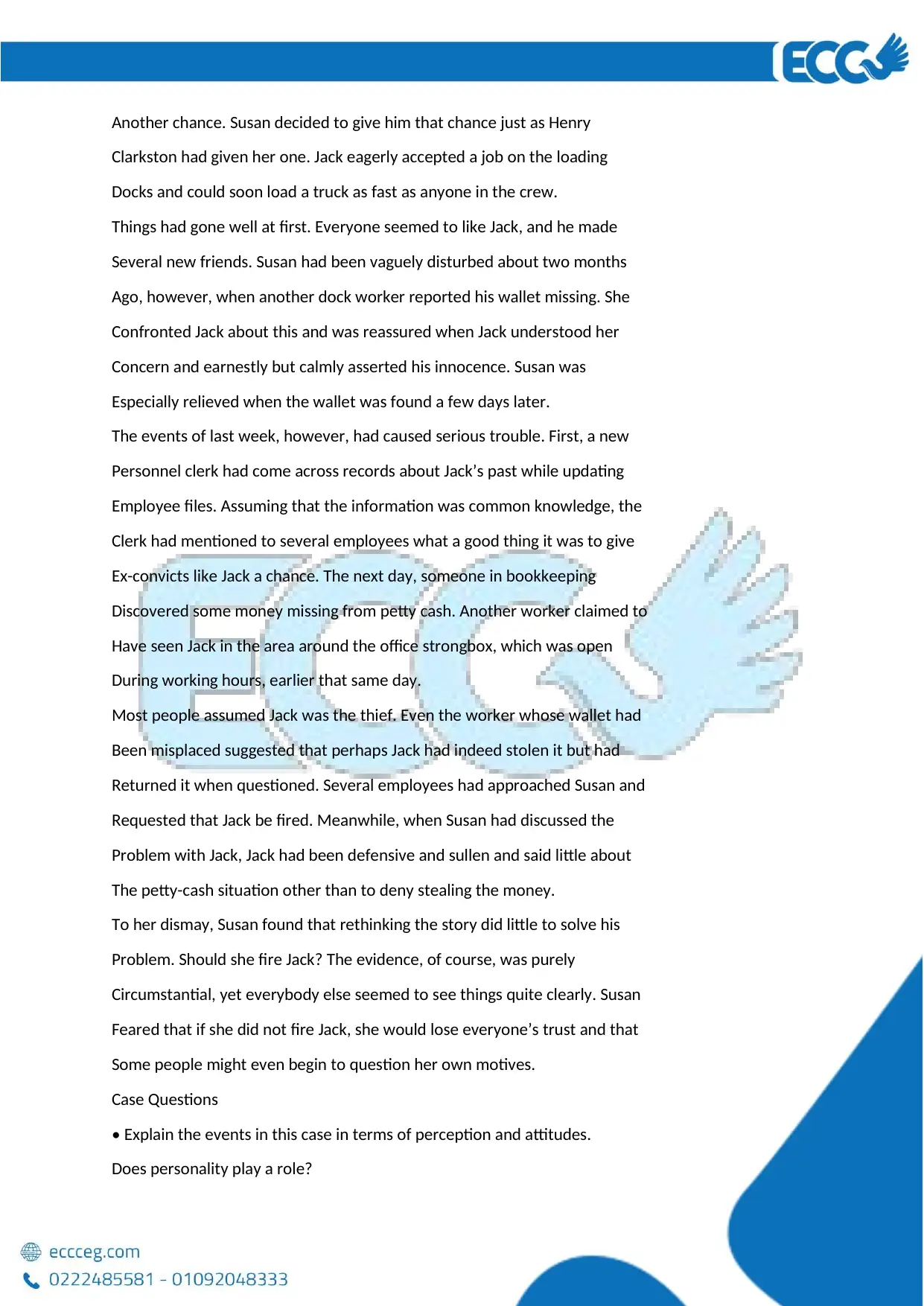
Another chance. Susan decided to give him that chance just as Henry
Clarkston had given her one. Jack eagerly accepted a job on the loading
Docks and could soon load a truck as fast as anyone in the crew.
Things had gone well at first. Everyone seemed to like Jack, and he made
Several new friends. Susan had been vaguely disturbed about two months
Ago, however, when another dock worker reported his wallet missing. She
Confronted Jack about this and was reassured when Jack understood her
Concern and earnestly but calmly asserted his innocence. Susan was
Especially relieved when the wallet was found a few days later.
The events of last week, however, had caused serious trouble. First, a new
Personnel clerk had come across records about Jack’s past while updating
Employee files. Assuming that the information was common knowledge, the
Clerk had mentioned to several employees what a good thing it was to give
Ex-convicts like Jack a chance. The next day, someone in bookkeeping
Discovered some money missing from petty cash. Another worker claimed to
Have seen Jack in the area around the office strongbox, which was open
During working hours, earlier that same day.
Most people assumed Jack was the thief. Even the worker whose wallet had
Been misplaced suggested that perhaps Jack had indeed stolen it but had
Returned it when questioned. Several employees had approached Susan and
Requested that Jack be fired. Meanwhile, when Susan had discussed the
Problem with Jack, Jack had been defensive and sullen and said little about
The petty-cash situation other than to deny stealing the money.
To her dismay, Susan found that rethinking the story did little to solve his
Problem. Should she fire Jack? The evidence, of course, was purely
Circumstantial, yet everybody else seemed to see things quite clearly. Susan
Feared that if she did not fire Jack, she would lose everyone’s trust and that
Some people might even begin to question her own motives.
Case Questions
• Explain the events in this case in terms of perception and attitudes.
Does personality play a role?
Clarkston had given her one. Jack eagerly accepted a job on the loading
Docks and could soon load a truck as fast as anyone in the crew.
Things had gone well at first. Everyone seemed to like Jack, and he made
Several new friends. Susan had been vaguely disturbed about two months
Ago, however, when another dock worker reported his wallet missing. She
Confronted Jack about this and was reassured when Jack understood her
Concern and earnestly but calmly asserted his innocence. Susan was
Especially relieved when the wallet was found a few days later.
The events of last week, however, had caused serious trouble. First, a new
Personnel clerk had come across records about Jack’s past while updating
Employee files. Assuming that the information was common knowledge, the
Clerk had mentioned to several employees what a good thing it was to give
Ex-convicts like Jack a chance. The next day, someone in bookkeeping
Discovered some money missing from petty cash. Another worker claimed to
Have seen Jack in the area around the office strongbox, which was open
During working hours, earlier that same day.
Most people assumed Jack was the thief. Even the worker whose wallet had
Been misplaced suggested that perhaps Jack had indeed stolen it but had
Returned it when questioned. Several employees had approached Susan and
Requested that Jack be fired. Meanwhile, when Susan had discussed the
Problem with Jack, Jack had been defensive and sullen and said little about
The petty-cash situation other than to deny stealing the money.
To her dismay, Susan found that rethinking the story did little to solve his
Problem. Should she fire Jack? The evidence, of course, was purely
Circumstantial, yet everybody else seemed to see things quite clearly. Susan
Feared that if she did not fire Jack, she would lose everyone’s trust and that
Some people might even begin to question her own motives.
Case Questions
• Explain the events in this case in terms of perception and attitudes.
Does personality play a role?
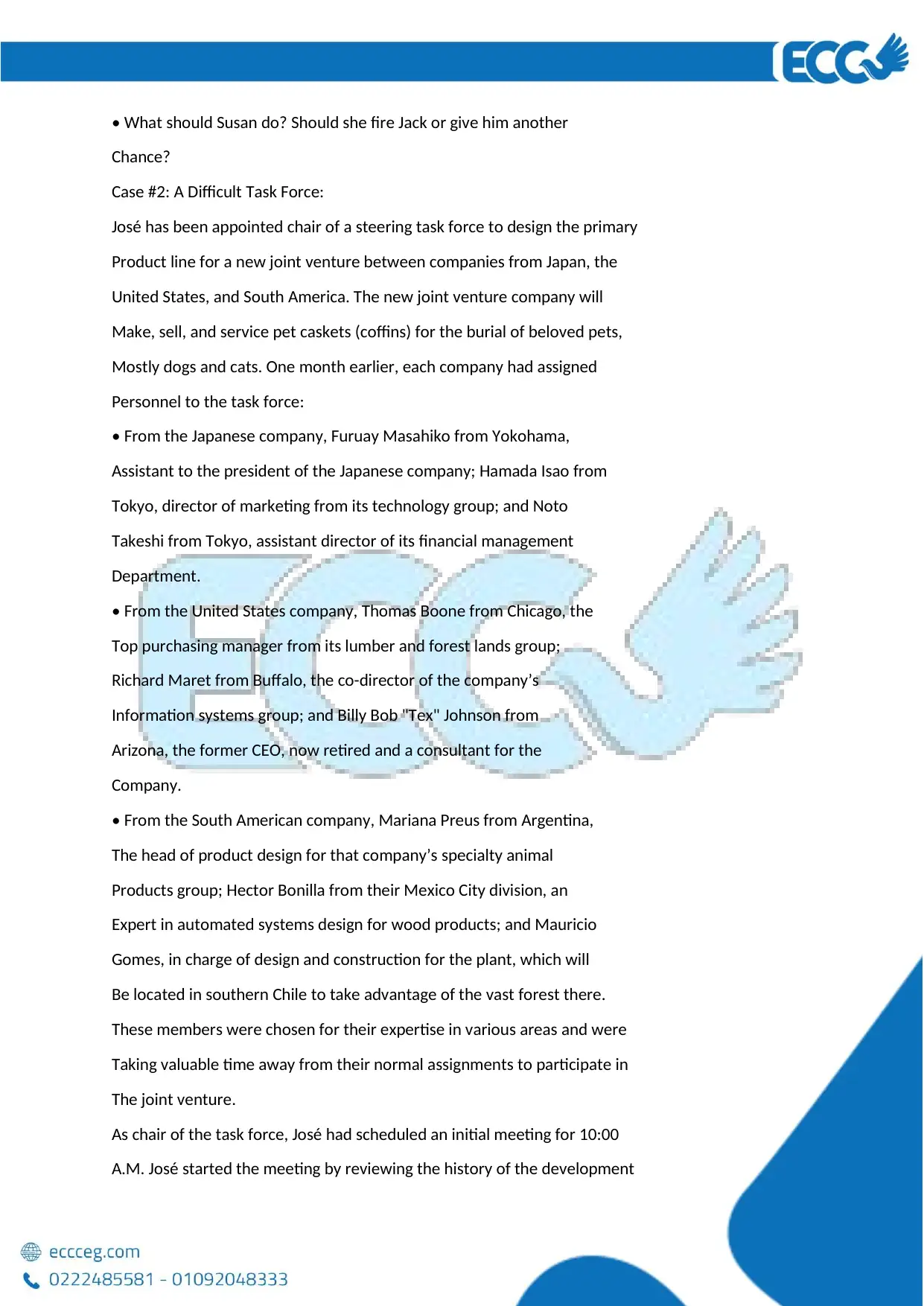
• What should Susan do? Should she fire Jack or give him another
Chance?
Case #2: A Difficult Task Force:
José has been appointed chair of a steering task force to design the primary
Product line for a new joint venture between companies from Japan, the
United States, and South America. The new joint venture company will
Make, sell, and service pet caskets (coffins) for the burial of beloved pets,
Mostly dogs and cats. One month earlier, each company had assigned
Personnel to the task force:
• From the Japanese company, Furuay Masahiko from Yokohama,
Assistant to the president of the Japanese company; Hamada Isao from
Tokyo, director of marketing from its technology group; and Noto
Takeshi from Tokyo, assistant director of its financial management
Department.
• From the United States company, Thomas Boone from Chicago, the
Top purchasing manager from its lumber and forest lands group;
Richard Maret from Buffalo, the co-director of the company’s
Information systems group; and Billy Bob "Tex" Johnson from
Arizona, the former CEO, now retired and a consultant for the
Company.
• From the South American company, Mariana Preus from Argentina,
The head of product design for that company’s specialty animal
Products group; Hector Bonilla from their Mexico City division, an
Expert in automated systems design for wood products; and Mauricio
Gomes, in charge of design and construction for the plant, which will
Be located in southern Chile to take advantage of the vast forest there.
These members were chosen for their expertise in various areas and were
Taking valuable time away from their normal assignments to participate in
The joint venture.
As chair of the task force, José had scheduled an initial meeting for 10:00
A.M. José started the meeting by reviewing the history of the development
Chance?
Case #2: A Difficult Task Force:
José has been appointed chair of a steering task force to design the primary
Product line for a new joint venture between companies from Japan, the
United States, and South America. The new joint venture company will
Make, sell, and service pet caskets (coffins) for the burial of beloved pets,
Mostly dogs and cats. One month earlier, each company had assigned
Personnel to the task force:
• From the Japanese company, Furuay Masahiko from Yokohama,
Assistant to the president of the Japanese company; Hamada Isao from
Tokyo, director of marketing from its technology group; and Noto
Takeshi from Tokyo, assistant director of its financial management
Department.
• From the United States company, Thomas Boone from Chicago, the
Top purchasing manager from its lumber and forest lands group;
Richard Maret from Buffalo, the co-director of the company’s
Information systems group; and Billy Bob "Tex" Johnson from
Arizona, the former CEO, now retired and a consultant for the
Company.
• From the South American company, Mariana Preus from Argentina,
The head of product design for that company’s specialty animal
Products group; Hector Bonilla from their Mexico City division, an
Expert in automated systems design for wood products; and Mauricio
Gomes, in charge of design and construction for the plant, which will
Be located in southern Chile to take advantage of the vast forest there.
These members were chosen for their expertise in various areas and were
Taking valuable time away from their normal assignments to participate in
The joint venture.
As chair of the task force, José had scheduled an initial meeting for 10:00
A.M. José started the meeting by reviewing the history of the development
⊘ This is a preview!⊘
Do you want full access?
Subscribe today to unlock all pages.

Trusted by 1+ million students worldwide
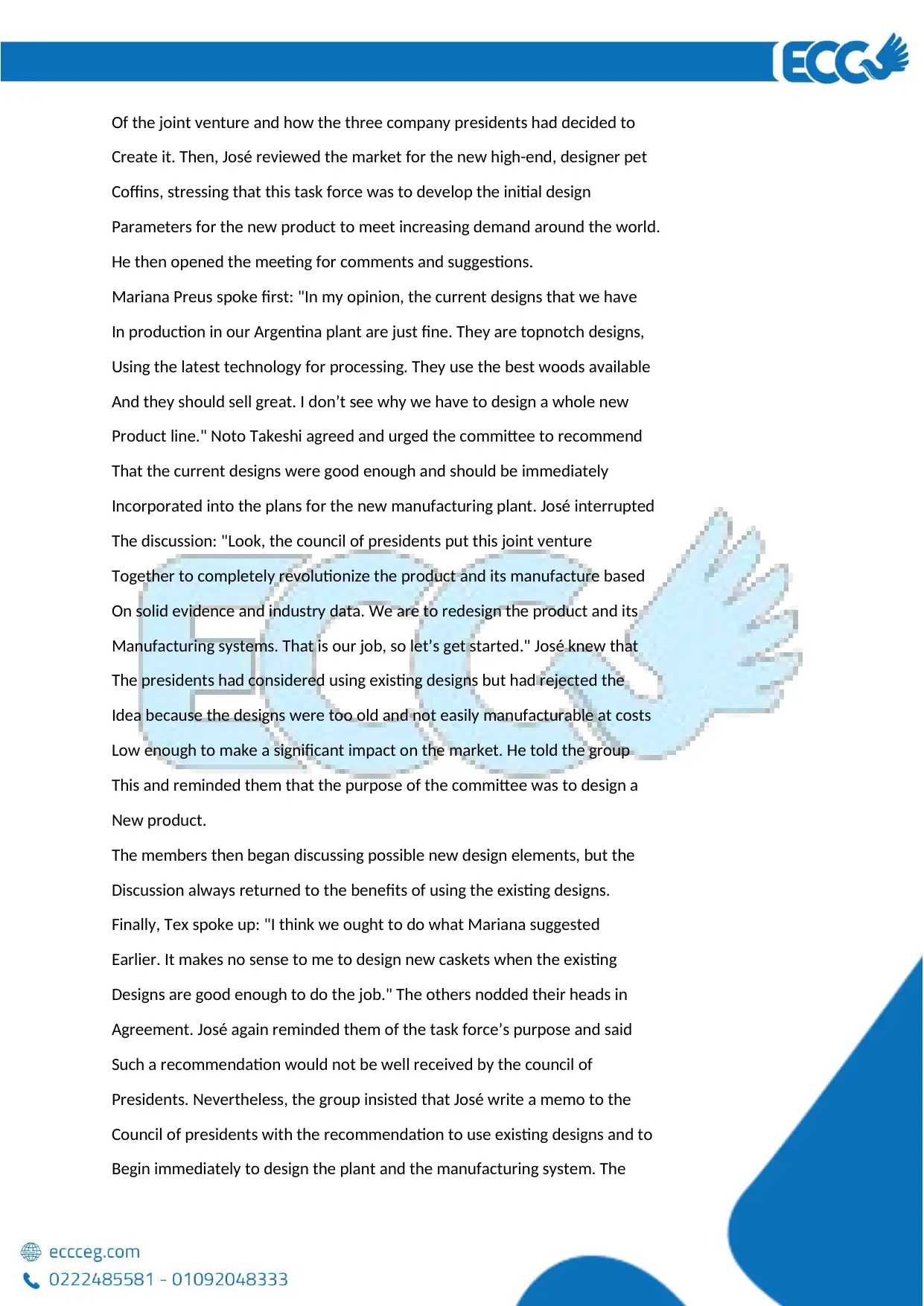
Of the joint venture and how the three company presidents had decided to
Create it. Then, José reviewed the market for the new high-end, designer pet
Coffins, stressing that this task force was to develop the initial design
Parameters for the new product to meet increasing demand around the world.
He then opened the meeting for comments and suggestions.
Mariana Preus spoke first: "In my opinion, the current designs that we have
In production in our Argentina plant are just fine. They are topnotch designs,
Using the latest technology for processing. They use the best woods available
And they should sell great. I don’t see why we have to design a whole new
Product line." Noto Takeshi agreed and urged the committee to recommend
That the current designs were good enough and should be immediately
Incorporated into the plans for the new manufacturing plant. José interrupted
The discussion: "Look, the council of presidents put this joint venture
Together to completely revolutionize the product and its manufacture based
On solid evidence and industry data. We are to redesign the product and its
Manufacturing systems. That is our job, so let’s get started." José knew that
The presidents had considered using existing designs but had rejected the
Idea because the designs were too old and not easily manufacturable at costs
Low enough to make a significant impact on the market. He told the group
This and reminded them that the purpose of the committee was to design a
New product.
The members then began discussing possible new design elements, but the
Discussion always returned to the benefits of using the existing designs.
Finally, Tex spoke up: "I think we ought to do what Mariana suggested
Earlier. It makes no sense to me to design new caskets when the existing
Designs are good enough to do the job." The others nodded their heads in
Agreement. José again reminded them of the task force’s purpose and said
Such a recommendation would not be well received by the council of
Presidents. Nevertheless, the group insisted that José write a memo to the
Council of presidents with the recommendation to use existing designs and to
Begin immediately to design the plant and the manufacturing system. The
Create it. Then, José reviewed the market for the new high-end, designer pet
Coffins, stressing that this task force was to develop the initial design
Parameters for the new product to meet increasing demand around the world.
He then opened the meeting for comments and suggestions.
Mariana Preus spoke first: "In my opinion, the current designs that we have
In production in our Argentina plant are just fine. They are topnotch designs,
Using the latest technology for processing. They use the best woods available
And they should sell great. I don’t see why we have to design a whole new
Product line." Noto Takeshi agreed and urged the committee to recommend
That the current designs were good enough and should be immediately
Incorporated into the plans for the new manufacturing plant. José interrupted
The discussion: "Look, the council of presidents put this joint venture
Together to completely revolutionize the product and its manufacture based
On solid evidence and industry data. We are to redesign the product and its
Manufacturing systems. That is our job, so let’s get started." José knew that
The presidents had considered using existing designs but had rejected the
Idea because the designs were too old and not easily manufacturable at costs
Low enough to make a significant impact on the market. He told the group
This and reminded them that the purpose of the committee was to design a
New product.
The members then began discussing possible new design elements, but the
Discussion always returned to the benefits of using the existing designs.
Finally, Tex spoke up: "I think we ought to do what Mariana suggested
Earlier. It makes no sense to me to design new caskets when the existing
Designs are good enough to do the job." The others nodded their heads in
Agreement. José again reminded them of the task force’s purpose and said
Such a recommendation would not be well received by the council of
Presidents. Nevertheless, the group insisted that José write a memo to the
Council of presidents with the recommendation to use existing designs and to
Begin immediately to design the plant and the manufacturing system. The
Paraphrase This Document
Need a fresh take? Get an instant paraphrase of this document with our AI Paraphraser
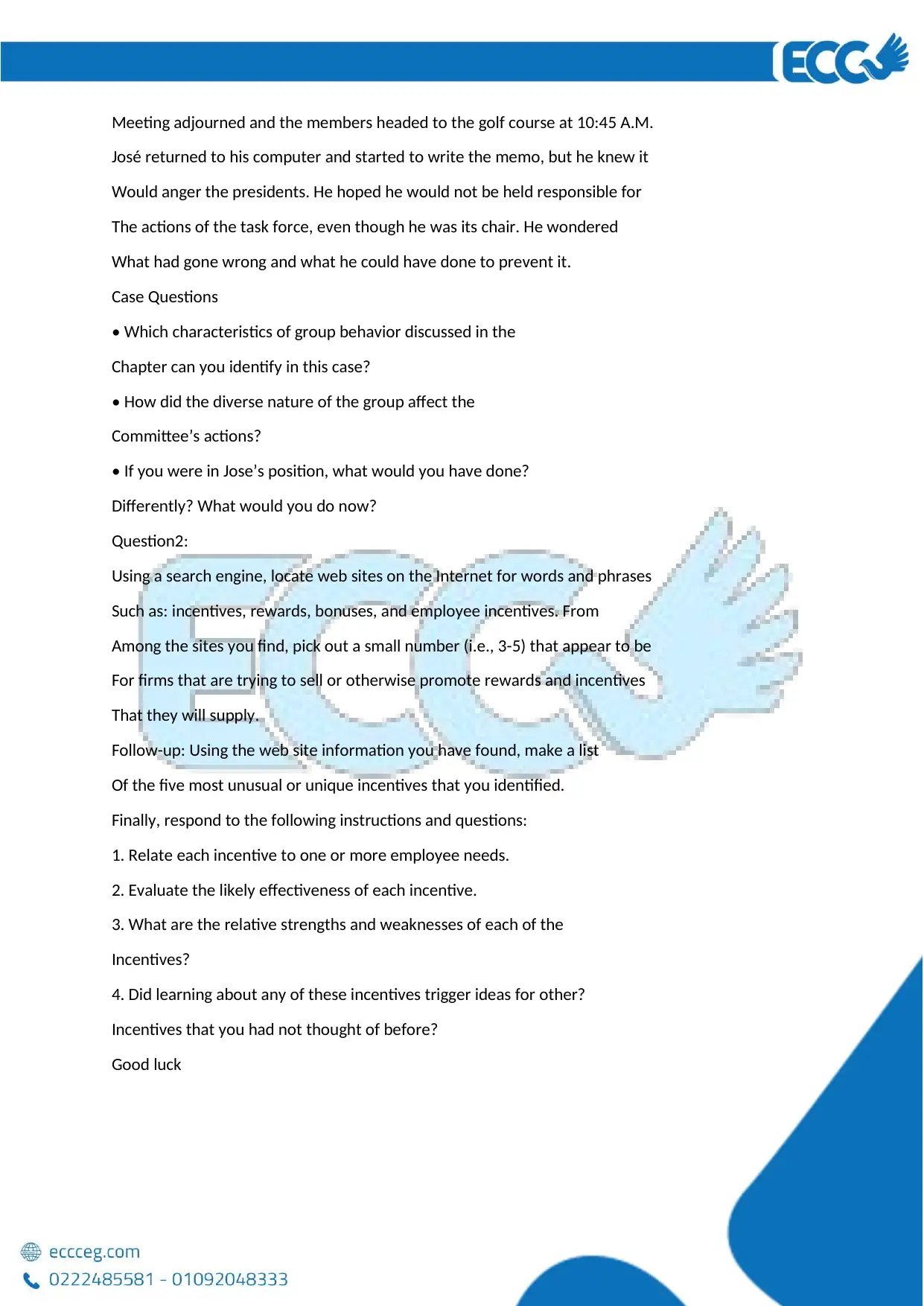
Meeting adjourned and the members headed to the golf course at 10:45 A.M.
José returned to his computer and started to write the memo, but he knew it
Would anger the presidents. He hoped he would not be held responsible for
The actions of the task force, even though he was its chair. He wondered
What had gone wrong and what he could have done to prevent it.
Case Questions
• Which characteristics of group behavior discussed in the
Chapter can you identify in this case?
• How did the diverse nature of the group affect the
Committee’s actions?
• If you were in Jose’s position, what would you have done?
Differently? What would you do now?
Question2:
Using a search engine, locate web sites on the Internet for words and phrases
Such as: incentives, rewards, bonuses, and employee incentives. From
Among the sites you find, pick out a small number (i.e., 3-5) that appear to be
For firms that are trying to sell or otherwise promote rewards and incentives
That they will supply.
Follow-up: Using the web site information you have found, make a list
Of the five most unusual or unique incentives that you identified.
Finally, respond to the following instructions and questions:
1. Relate each incentive to one or more employee needs.
2. Evaluate the likely effectiveness of each incentive.
3. What are the relative strengths and weaknesses of each of the
Incentives?
4. Did learning about any of these incentives trigger ideas for other?
Incentives that you had not thought of before?
Good luck
José returned to his computer and started to write the memo, but he knew it
Would anger the presidents. He hoped he would not be held responsible for
The actions of the task force, even though he was its chair. He wondered
What had gone wrong and what he could have done to prevent it.
Case Questions
• Which characteristics of group behavior discussed in the
Chapter can you identify in this case?
• How did the diverse nature of the group affect the
Committee’s actions?
• If you were in Jose’s position, what would you have done?
Differently? What would you do now?
Question2:
Using a search engine, locate web sites on the Internet for words and phrases
Such as: incentives, rewards, bonuses, and employee incentives. From
Among the sites you find, pick out a small number (i.e., 3-5) that appear to be
For firms that are trying to sell or otherwise promote rewards and incentives
That they will supply.
Follow-up: Using the web site information you have found, make a list
Of the five most unusual or unique incentives that you identified.
Finally, respond to the following instructions and questions:
1. Relate each incentive to one or more employee needs.
2. Evaluate the likely effectiveness of each incentive.
3. What are the relative strengths and weaknesses of each of the
Incentives?
4. Did learning about any of these incentives trigger ideas for other?
Incentives that you had not thought of before?
Good luck
1 out of 5
Your All-in-One AI-Powered Toolkit for Academic Success.
+13062052269
info@desklib.com
Available 24*7 on WhatsApp / Email
![[object Object]](/_next/static/media/star-bottom.7253800d.svg)
Unlock your academic potential
Copyright © 2020–2025 A2Z Services. All Rights Reserved. Developed and managed by ZUCOL.

